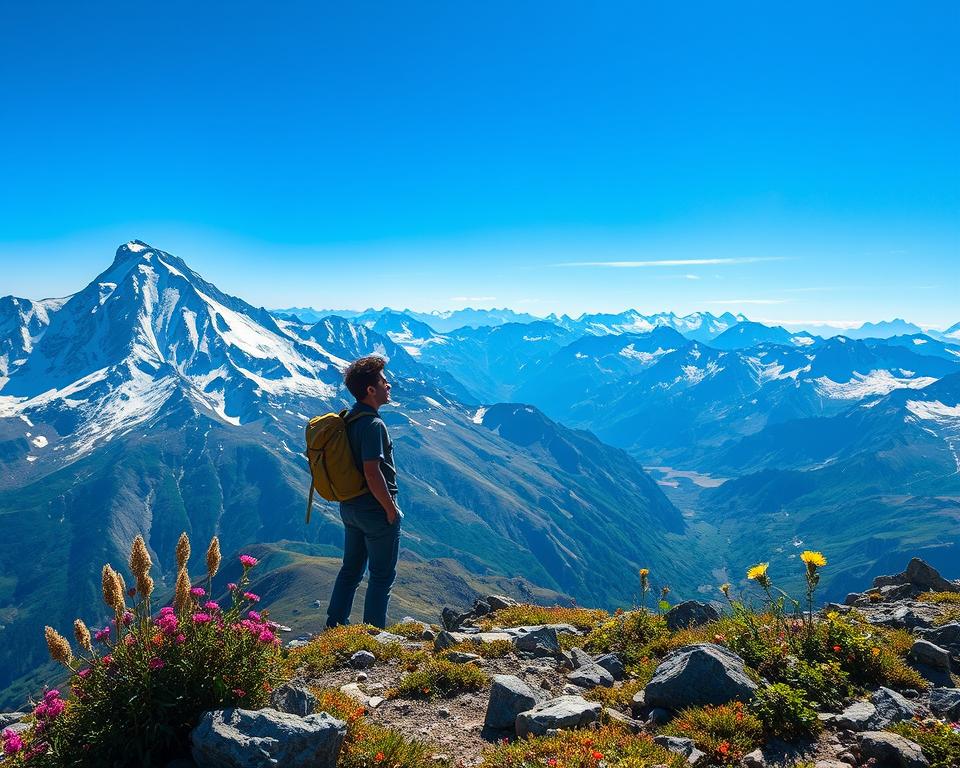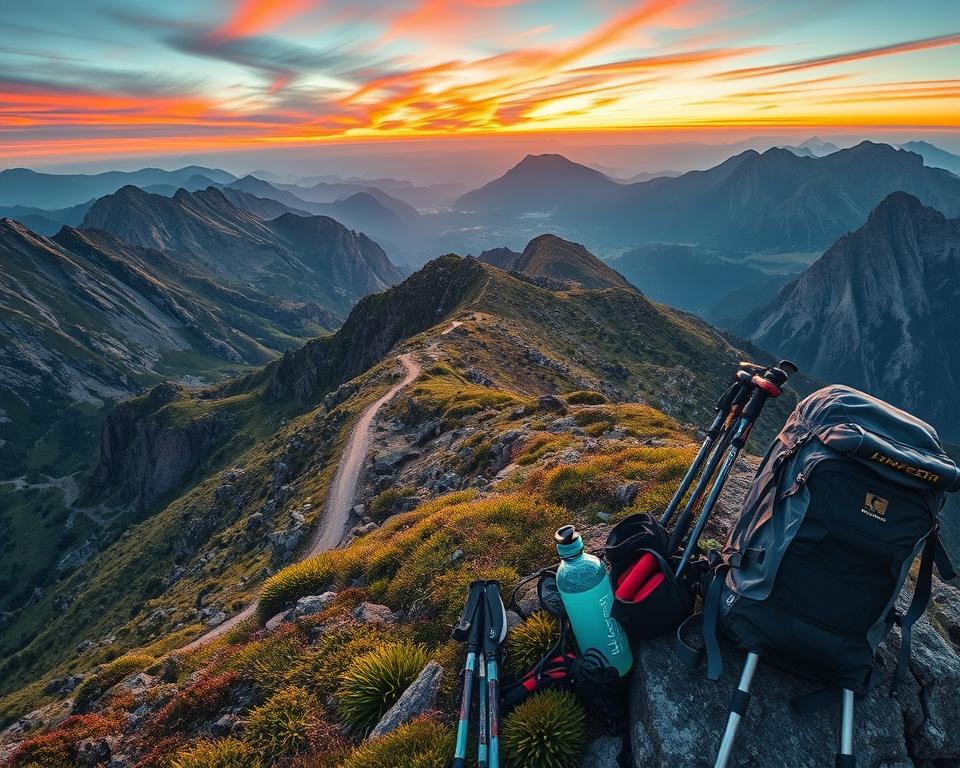High-altitude hiking is an exciting adventure, yet it demands careful planning. Consider how the lower oxygen levels high up will affect you. Getting ready with the right gear, knowledge, and fitness level is key to a safe hike. This guide will show you how to prepare and prevent altitude sickness for an enjoyable journey.
Staying hydrated is super important for a high-altitude hike. Bring tasty food, clothes that protect from the sun, and strong sunscreen. It’s a good idea to take medications like Ibuprofen or Diamox for altitude sickness. Working on your fitness before the hike is also crucial.
Knowing how to adjust to higher altitudes is essential. Slowly getting used to the elevation, especially at the start, helps your body adapt. Spot the signs of altitude sickness early to react promptly. These include headaches, trouble walking, and feeling very tired or confused.
Being aware of altitude sickness risks is part of getting ready. Having had Acute Mountain Sickness (AMS) before, certain health issues, and living at sea level increase your risks. Keep hydrated and well-fed, and skip the alcohol. This ensures your body adjusts well before you do anything strenuous. With careful planning, hiking at high altitudes can be a fantastic experience.
Essential Gear for High-Altitude Hiking
Getting ready for high-altitude hikes means picking the right gear with care. You need strong footwear and dependable hydration packs, among other things. Each piece of equipment is key for your safety and comfort while hiking high up.
Clothing and Footwear
Choose clothes that protect you from UV rays and sweat well. At high elevations, the sun is stronger. So, sunglasses that block UV rays and sunscreen are a must. Go for Merino-wool or synthetic layers instead of cotton because they keep you dry by wicking away sweat. For shoes, pick sturdy hiking boots that support your ankles well. Since foot injuries are common, good boots matter. Wool socks are great too. They adjust to your body’s temperature fast and dry quickly.
Navigation and Safety Equipment
Having the right navigation and safety tools is vital. A GPS device is very helpful, but also bring a compass and a map just in case. Personal locator beacons (PLBs) are crucial for safety during high-altitude hikes. They help rescue teams find you if you’re in danger. Also, don’t forget a first-aid kit that’s big enough for your whole group.
Nutrition and Hydration
Eating right and staying hydrated are super important. Try to get 50-60% of your energy from carbs. This will keep your energy up. Bring snacks like trail mix and energy bars that are high in calories and easy to eat on the move. Hydration packs make drinking water easy and keep your hands free. Drink three to four quarts of water a day to stay safe from altitude sickness. Be sure to sip water throughout the day to avoid hyponatremia, which can happen if you drink too much, too quickly.
Understanding Acclimatization: Preparing Your Body
Acclimatization is vital for high-altitude hiking. Knowing how it works ensures your safety and peak performance up high.

What is Acclimatization?
Acclimatization means your body adjusts to higher places. When you go up, there’s less oxygen. Your body changes to handle it. Hypoxia is when your tissues don’t get enough oxygen. The CDC says acclimating to 6,000 feet takes around 3 weeks. For 14,000 feet, it can take up to 7 weeks.
Acclimatization Tips
- Stay Well Hydrated: Being well-hydrated helps you adjust.
- Gradual Ascent: Don’t go up more than 1,600 feet daily in your sleep place. Aspen Hospital and CDC recommend this.
- Rest Days: Take breaks to let your body adapt. Staying at trailheads or campsites before going higher helps.
- Pre-Acclimatization Techniques: Try altitude simulation tents or altitude fitness studios, like Traverse Fitness in Denver, before your hike.
- Medications: Think about preventive meds like Diamox or Dexamethasone to stop altitude sickness.
- Light Activities: Do light activities before hard work.
- Avoid Alcohol and Tobacco: They hurt the acclimatization process and make altitude sickness symptoms worse.
Symptoms of Altitude Sickness
About 75% of people over 10,000 feet get altitude sickness. Knowing symptoms is key to prevention. They start within 12-24 hours after reaching high and can include:
- Headache
- Nausea and Vomiting
- Shortness of Breath
- Dizziness or Lightheadedness
- Fatigue
- Insomnia
Watch these symptoms closely. If they get worse, act fast. Going down or resting helps. Keep climbing without adjusting risks serious, even deadly, health issues. Always put your well-being first.
How to Prepare for a Hike at Altitude
Getting ready for a high-altitude hike means knowing how to acclimate your body. Start preparing months in advance. The air gets thinner above 8,000 feet, so give your body time to adjust.
To plan a good hike, increase your altitude slowly. Aim to go up by 500-700 meters per day. This method stops you from working too hard and helps your body get used to less oxygen. Also, following the “climb high, sleep low” rule works well. It means you climb up during the day and sleep at a lower altitude at night.
Watching how your body reacts is key when hiking up high. If you get headaches, feel sick, or have trouble breathing, these could be signs of Acute Mountain Sickness (AMS). Don’t ignore these symptoms. Always tell someone if you’re feeling unwell and take precautions.
Staying hydrated is crucial in the mountains. You lose water faster at high altitudes, so drink 32-48 extra ounces of water every day. Make sure you carry enough water, like two 1-liter bottles and a 3-liter CamelBak type Water Bladder. This way, you’ll stay hydrated throughout your hike.
It’s also smart to pack foods high in calories and have medicine for altitude sickness, like Diamox. Talk to your healthcare provider for advice on food and medicine before you leave. This will help you avoid health issues.
Start your prep early, understand important details, and listen to your body. Doing this will make your high-altitude hiking safer and more enjoyable.
Fitness and Training Tips for High-Altitude Hiking
Getting ready for a high-altitude hike is a big deal. It’s not just about getting used to less oxygen. A strong fitness plan is key for doing well and staying safe on your hike. You’ll need good heart health and a training plan for high places. Here’s what you need to know about fitness and training for your hike.
Cardiovascular Training
Having a strong heart is vital for high-altitude hiking. Use high-intensity interval training (HIIT) to boost your VO2 max. This makes your body better at using oxygen. Include stair climbing in your workouts to prepare for uphill climbs. Taking on an 18-story building’s stairs is a great way to build leg power and endurance.
Make sure you do a long workout each week that’s all about your sport. This should be 30 to 50 percent of your total training time.
Strength and Endurance Exercises
Strength and staying power are must-haves for trail challenges. Lifting weights and doing resistance exercises help a lot. You can also tackle small hill repeats for a few hours. This is a good test for the real thing. If you can’t get to trails, try marathon step-up exercises. Switch feet on each step.
Pre-Trip Workouts and Recovery
Your workouts before the trip should look like what you’ll do on the hike. If long sessions are too much, split them into two shorter ones. It’s important to slowly up the distance and toughness of your hikes each week.
Training with a heavier pack than you’ll actually carry helps build strength. Just don’t add more than 10% weight each week. Recovery time is also key to avoid muscle issues and other problems from high altitudes. Keep pushing yourself, get comfortable with being bored, and always aim to get better with every high-elevation training session.
How Does Training for a Thru-Hike Prepare You for High-Altitude Hiking?
Training for a thru-hike not only builds physical endurance but also helps you acclimate to varying conditions. As you prepare for your thruhike, you’ll develop essential skills like navigation and pack management. This experience enhances your confidence and adaptability, making high-altitude hiking a more achievable and enjoyable adventure.
Conclusion
Starting a high-altitude hiking trip means you need to be well-prepared. You should understand both the risks and the rewards of hiking at high elevations. Choosing the right gear, like clothes and shoes, is important. Also, carrying navigation and safety gear can make your hike better. Plus, getting into good shape with cardio and strength exercises helps a lot.
Getting used to the altitude is key for a safe hike. You should climb slowly and know the signs of altitude sickness. These signs include acute mountain sickness, lung issues, and brain swelling. Drinking plenty of water, eating right, and protecting yourself from the sun are also key. Most avalanches happen because of people, so staying alert and sometimes hiring local guides is smart.
To have a safe hike, know your limits and learn from past hikes at lower elevations. Early training, starting 3-4 months before your trip, is a good idea. Increase your training slowly each week. Being ready, knowing what to expect, and being able to change plans can make your hike a great experience. For more tips on getting ready for high-altitude hikes, check out this useful guide.

